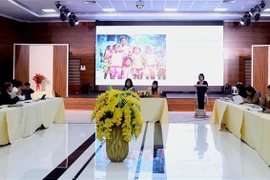Speaking at a meeting on June 13, Bui Thanh Giang, Deputy General Directorof State-owned Saigon Water Corporation (SAWACO), said the city is facingmultiple challenges in supplying clean and safe water, including excessiveexploitation of groundwater.
“Up to 16% of the city’s households used groundwater extractedfrom wells last year. The figure was 15% in the first five months of thisyear,” he said.
Around 94% of the city’s water comes from the Sai GonRiver and Dong Nai River, which is home to a number of factories and industrialparks discharging wastewater into the rivers, with many of them lackingadvanced wastewater treatment technology.
The city also lacks reserve reservoirs to store clean water incase of water shortages, he added.
The company currently supplies clean water to households inalmost all districts (except for Cu Chi district, which is supplied by WaterInfrastructure JSC) and Thu Duc city, he said.
It targets increasing the average supply of water per capita perday by 165 litres and reducing the tap water leakage rate to 15% by 2025.
By then, the city water supply capacity will reach 3.6million cu.m per day, using only 100,000 cu.m of groundwater.
Climate change
Dr Nguyen Minh Hoa, senior lecturer at the Faculty of UrbanStudies of HCM City University of Social Sciences and Humanities, said climatechange might disrupt the city’s water resources.
Climate change will affect where, when, and how much water isavailable, which can harm the health of people and ecosystems, he said.
These impacts are especially likely to happen in the country’slow-lying areas such as the Cuu Long (Mekong) Delta and HCM City, he said.
Experts have warned if the sea level rises by 0.7-1m, theentire Mekong Delta region and 72% of HCM City’s area will be underwater.
Climate change also threatens to increase the salinity ofwater and groundwater through saltwater intrusion, he said.
Drought is likely to cause reservoirs such as Tri An and Deu Tiengto dry up.
People’s demand for freshwater is on the rise due to a risingpopulation. The city’s population on average increases by 250,000 people everyyear (mostly migrants coming to the city for work). Its population is expectedto reach 10 million by 2030 and 15 million by 2050.
The city is expected to receive 8-10 million internationaltourists and 15-20 million domestic tourists per year.
Its water supply will need to increase to meet the demandfor 200-300 litres of water per person per day.
The creation of new urban areas will also require a larger andstronger water supply system.
Recommendations
To help reduce climate risks, the city should consider potentialimpacts on their systems and take steps to build resilience, expertsnoted.
People can also take steps to use water efficiently and help keepbodies of water clean, they said.
Water supply works in industrial parks and other businessestablishments must be closely monitored to prevent groundwaterexploitation.
The city’s Department of Natural Resources and Environment needsto carry out inspections, risk management, and preparations for incidents ordisasters related to water supply and water security.
The city will need to call for additional investmentin a clean water supply system.
The government last year approved a resilience projectspecifically focused on water resources developed by the Ministry ofAgriculture and Rural Development./.





























